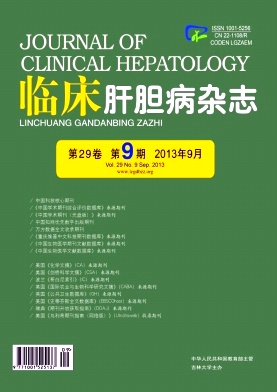Objective To investigate the therapeutic effect of telbivudine combined with Fuzheng Huayu tablets in the treatment of liver fibrosis in chronic hepatitis B ( CHB) . Methods A total of 120 patients with CHB, who were admitted to our hospital from July 2011 to November 2012, were randomly divided into treatment group ( n = 60) and control group ( n = 60) . All patients received antiviral and liver-protecting therapy with telbivudine; meanwhile, the treatment group was given Fuzheng Huayu tablets as an addition for 6 months. The liver function, four indices for liver fibrosis, and patient' s symptoms and signs were evaluated. The enumeration data were analyzed by chi-square test, and the measurement data were analyzed by t- test. Results After 6 months of treatment, the treatment group showed normalized aspartate aminotransferase ( AST) , albumin / globulin ratio ( A / G) , and total bilirubin ( TBil) as well as decreased alanine aminotransferase ( ALT) , and there were significant differences between the treatment group and control group in AST ( 33. 1 ± 15. 5 vs 39. 5 ± 18. 4, t = 2. 060, P < 0. 05) , A / G ( 1. 78 ± 0. 41 vs 1. 64 ± 0. 32, t = 2. 085, P < 0. 05) , TBil ( 13. 8 ± 6. 6 vs 17. 9 ± 8. 3, t = 3. 172, P <0. 05) , and ALT ( 55. 3 ± 23. 4 vs 64. 7 ± 27. 6, t = 2. 012, P < 0. 05) ; also, the treatment group showed significant improvements in hyaluronic acid ( HA) , laminin ( LN) , type Ⅲ procollagen peptide ( PⅢP) , and type Ⅳ collagen ( Ⅳ- C) , and there were significant differences between the treatment group and control group in HA ( 107. 7 ± 82. 3 vs 141. 6 ± 91. 4, t = 2. 155, P < 0. 05) , LN ( 125. 4 ± 73. 2 vs154. 9 ± 76. 5, t = 2. 135, P < 0. 05) , PⅢP ( 0. 61 ± 0. 56 vs 0. 96 ± 0. 44, t = 3. 266, P < 0. 05) , and IV- C ( 90. 6 ± 78. 3 vs 134. 3 ±67. 9, t = 3. 807, P < 0. 05) . In addition, the treatment group had alleviated lassitude, improved appetite, and palliated abdominal distension, demonstrating significant differences compared with the control group ( 71. 7% vs 53. 3%, P < 0. 05; 83. 3% vs 65. 0%, P < 0. 05;80. 0% vs 58. 3%, P < 0. 05) . Conclusion When used along with Fuzheng Huayu tablets, telbivudine has better performances in relieving symptoms, improving liver function, and reducing liver fibrosis in CHB patients with liver fibrosis.














 DownLoad:
DownLoad: